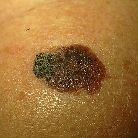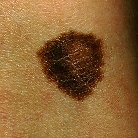Melanoma
The American Cancer Society and Centers for Disease Control estimates over 75,000 new cases of malignant melanoma diagnosed will be diagnosed in 2016.

Melanomas are very dangerous skin cancers. Approximately five percent (5%) of all skin malignancies are melanomas. Melanoma may spread (metastasize) to other areas of the body, if not detected early, and may eventually kill.



Images from left to right: Benign mole, Dysplastic mole, Malignant melanoma
The ABCDEF method (see photos above) may help detect melanoma: A (most early melanomas are asymmetrical); B (borders of melanomas are uneven); C (color; varied shades of brown, tan, or black are often the first sign of melanoma); and D (diameter; early melanomas tend to grow larger than common moles, greater than 6 mm in diameter), E (elevation or enlargement, areas of melanoma may be elevated above the level of the adjacent skin and appear as small nodules, itch, ulcerate, or bleed) and F (funny looking skin lesion especially if increasing in size or changing color).
The major risk factors for developing cutaneous melanoma are (in order of decreasing importance): (1) a new mole or pre-existing mole that has changed or is changing, (2) dysplastic moles with a prior personal history of melanoma and familial melanoma history, (3) dysplastic moles, and (4) large congenital moles. Melanoma may develop “de novo” from apparently “normal skin”. People with a history of “blistering” sunburns should be closely examined throughout life for melanomas. Each year, malignant melanoma kills over 110,000 people worldwide. Routine self examination of one’s skin is a very important component of early diagnosis of melanoma.